'Late Spring' (1949)
"Late Spring" is a classic Japanese film directed by Yasujirō Ozu and released in 1949. This beautifully crafted drama is part of Ozu's acclaimed "Noriko Trilogy" and is widely regarded as one of his finest works. With its contemplative storytelling, meticulous composition, and poignant exploration of family dynamics and societal expectations, "Late Spring" remains a timeless masterpiece of Japanese cinema.

Plot and Setting
Set in post-World War II Japan, "Late Spring" follows the story of Noriko, a young woman who lives with her widowed father, Professor Somiya. As Noriko reaches marriageable age, her father and their friends become increasingly concerned about her future and urge her to marry. The film delicately portrays Noriko's internal struggle as she navigates societal expectations, her loyalty to her father, and her own desires for independence and happiness.
Ozu's Unique Style
"Late Spring" exemplifies Yasujirō Ozu's distinct directorial style, known as the "Ozu Touch." His deliberate use of static camera shots, low-angle framing, and symmetrical compositions creates a sense of stillness and contemplation. Ozu's attention to everyday details and his emphasis on subtle gestures and facial expressions allow for profound emotional depth and introspection.
Themes of Tradition and Duty
At its core, "Late Spring" explores themes of tradition, duty, and the conflicts between individual desires and societal expectations. The film depicts the tensions between the older generation's adherence to tradition and the younger generation's desire for personal fulfillment. Noriko's internal struggle reflects the pressures faced by many individuals caught between their own aspirations and the expectations of their families and society.
Father-Daughter Relationship
The relationship between Noriko and her father serves as the emotional core of "Late Spring." Their bond is characterized by love, respect, and sacrifice. The film delves into the complexities of their relationship, as her father grapples with his own desires for her future and Noriko struggles with the burden of fulfilling her duty as a daughter. The nuanced performances by Setsuko Hara as Noriko and Chishū Ryū as Professor Somiya capture the subtleties of their connection, evoking both heartwarming moments and quiet sadness.
Visual Symbolism
"Late Spring" is renowned for its masterful use of visual symbolism, which enhances the narrative and deepens the emotional impact. Ozu often employs motifs such as trains, cherry blossoms, and traditional Japanese architecture to represent the passage of time, transience, and the clash between tradition and modernity. These visual elements contribute to the film's poetic and contemplative atmosphere.
Subtlety and Emotional Resonance
One of the film's greatest strengths lies in its subtlety and the emotions it evokes through restraint. Ozu avoids melodrama, allowing the audience to experience the characters' emotions through quiet moments and understated performances. The emotional resonance of "Late Spring" lies in its ability to capture the universal struggles of love, sacrifice, and the complexities of human relationships.
Also Check Nvidia: Lovelace and Hopper Successors Leaked?
Conclusion
"Late Spring" stands as a cinematic masterpiece that continues to captivate audiences with its profound storytelling, visual poetry, and timeless themes. Yasujirō Ozu's meticulous craftsmanship and the exceptional performances by the cast create a deeply moving and introspective exploration of family, tradition, and personal desires. With its universal resonance and enduring impact, "Late Spring" remains a testament to the power of cinema to reflect the complexities of the human experience.





























